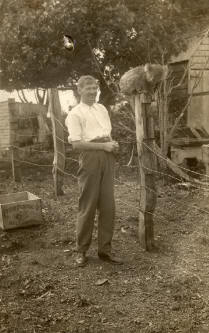Nicholas Kotzebue
| Alias | Niklos Kotsebue |
|---|---|
| Russian spelling | Николай Коцебу |
| Born | 18.02.1884 (first nat.), 20.02.1879 (second nat.) |
| Place | Ekaterinburg, Russia |
| Ethnic origin | Russian/German |
| Religion | Roman Catholic |
| Mother | Mrs Rennkampt |
| Residence before arrival at Australia | When 4 years old, after father's death, family moved to Revel (Tallinn); when 14-16 years old lived in Germany; was at sea; served in French legion, escaped from it in Singapore; was in America, returned to Russia. |
| Arrived at Australia |
from London on 24.10.1903 (first nat.); 1.09.1899 (second nat.) per Sterna disembarked at Fremantle, WA |
| Residence before enlistment | WA, SA, Warrandyte in Vic. |
| Occupation | 1915 sailor, mechanic; 1920 axeman, an inventor; 1933 engineer |
| Naturalisation | 1915, 1920 |
| Residence after the war | Melbourne |
| Died | 25.05.1952, Bundoora, Victoria |
Service #1
| Service number | 5074 |
|---|---|
| Enlisted | 9.07.1915 |
| Place of enlistment | Melbourne |
| Unit | 2nd Field Company Engineers; 1st ANZAC Wireless School Battalion, 1st Anzac Intelligence Police, 2nd Field Company Engineers |
| Rank | Private, Driver |
| Place | Western Front, 1916-1917 |
| Casualties | WIA 1917 |
| Final fate | RTA 16.12.1917 |
| Discharged | 30.03.1918 MU |
Materials
Digitised naturalisation 1 2 (NAA) (Kotsebue & Kotzebie)
Digitised service records (NAA) (Kotzebue)
Digitised Embarkation roll entry (AWM)
Intelligence file (NAA) (Kotzebue)
Applications for letter patent for inventions 1 2 3 4 5 (NAA) (Kotzebue)
Blog article
Newspaper articles
Grubbing Demonstration. Soldier's Invention a Success. - The Age, Melbourne, 25 November 1919, p. 9.
Revolver-carrying habit. - The Argus, 14 December 1920, p. 7.
Revolver-carrying habit. - The Argus, 18 December 1920, p. 19.
Crippled man injured. - Age, Melbourne, 3 September 1923, p. 11.
From Russian Anzacs in Australian History:
The case of Nicholas Kotzebue [...] is well-documented. The bearer of a distinguished German name, Kotzebue was born in the Ural Mountains, where his father was involved in goldmining; his father died four years later and the family moved to Revel in Estonia, where Nicholas was brought up. As a teenager he spent two years in Germany and finally, after many adventures, settled in Australia at the end of the 19th century, when he was 20 years old. Having been a mechanic before enlisting in the AIF, he served in France with the Engineers, and subsequently studied at the Anzac wireless school. Then he had a brief spell, from April to August 1917, with the 1st Anzac Intelligence Police. He returned to his unit and in early 1918 was invalided back to Australia with wounds received at Ypres, although he arrived back not just with physical wounds but in a mentally disturbed state, too. It is very painful to read the letters with which he bombarded the Intelligence section. Through the incoherent jumble of his words, and through his fears of persecution, his main obsession emerges -- to prove that he is not German (I could have demonstrated that, culturally, he was definitely Russian; for in these letters his handwriting still occasionally slipped into Russian script, even after more than 20 years away from Russia, and despite his mental illness). He also develops a determination to prove that not all those with 'names ending in skii in Russia are scoundrels'. Among his letters Kotzebue has a photo of himself beside a koala sitting on a post, accompanying his 'little joke', written out in his inimitable orthography: 'The other day the found this indevidual on top of a telegraph post undobtetly communicating the boght me to inturpet but I culdent make out was his name Teddy Bear or Teddy Berg in this last case it would be german. Culd I advis dath it meight auer clever detectives Billinghurst and Davies wuld see in to the matter and decide shuld he be inturned or just sent op a gum tree. he is behaving very peculiare at thimes, screwing in a ball and grunting like a pig.' To be fair to the Intelligence officials, however, they always treated Kotzebue with respect.
Gallery

Nicholas Kotzebue attempting to interpret Teddy Berg's subversive messages
NAA: MP 16/1, 1918/296
 Russian Anzacs
Russian Anzacs